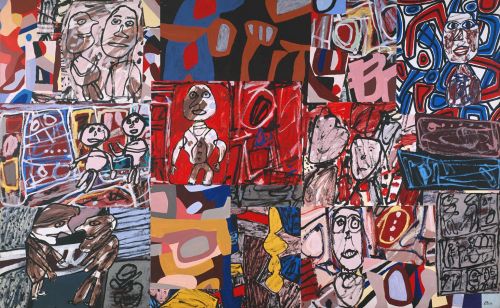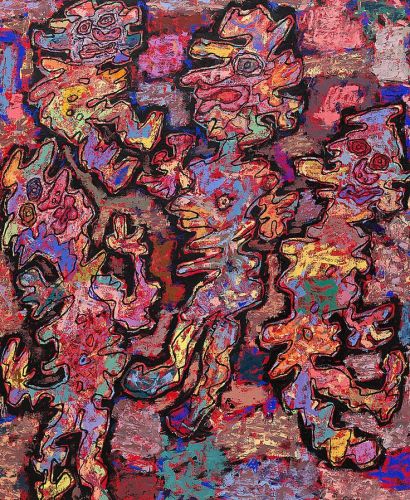Jean Dubuffet
B. 1901, LE HAVRE, FRANCE; D. 1985, PARIS
Jean Dubuffet was born on July 31, 1901, in Le Havre, France. He attended art classes in his youth and in 1918 moved to Paris to study at the Académie Julian, which he left after six months.
During this time, Dubuffet met Raoul Dufy, Max Jacob, Fernand Léger, and Suzanne Valadon and became fascinated with Hans Prinzhorn’s book on psychopathic art.
He traveled to Italy in 1923 and South America in 1924. Then Dubuffet gave up painting for about ten years, working as an industrial draftsman and later in the family wine business. He committed himself to becoming an artist in 1942.


Dubuffet’s first solo exhibition was held at the Galerie René Drouin, Paris, in 1944; the Pierre Matisse Gallery gave him his first solo show in New York in 1947.
During the 1940s, the artist associated with André Breton, Georges Limbour, Jean Paulhan, and Charles Ratton, and his style and subject matter owed a debt to Paul Klee.
From 1945, he collected Art Brut, spontaneous, direct works by untutored individuals, such as the mentally ill and children. He additionally founded the organization Compagnie de l’Art Brut (1948–51) together with writers, critics, and dealers from Dada and Surrealist circles. For the first public Art Brut exhibition at Galerie René Drouin in 1949, Dubuffet published a manifesto in which he proclaimed the style’s superiority over officially recognized art.


From 1951 to 1952, Dubuffet lived in New York. He then returned to Paris, where a retrospective of his work took place at the Cercle Volney in 1954.
His first museum retrospective occurred in 1957 at the Schlo Morsbroich (now Museum Morsbroich), Leverkusen, West Germany.
Dubuffet exhibitions were subsequently held at the Musée des arts décoratifs, Paris (1960–61); Museum of Modern Art, New York, and Art Institute of Chicago (1962); Palazzo Grassi, Venice (1964); Tate Gallery, London, and Stedelijk Museum, Amsterdam (1966); and Guggenheim Museum (1966–67).

A collection of Dubuffet’s writings, Prospectus et tous écrits suivants (Prospectus and all subsequent texts), was published in 1967, the same year he started his architectural structures.
Soon thereafter, he began numerous commissions for monumental outdoor sculptures. In 1971, he produced his first theater props, the “practicables.”
A Dubuffet retrospective was presented at the Akademie der Künste, Berlin; Museum moderner Kunst, Vienna; and Joseph-Haubrichkunsthalle, Cologne (1980–81). In 1981, the Guggenheim Museum observed the artist’s 80th birthday with an exhibition. He was also the subject of a major retrospective at the Centre Georges Pompidou (2001).
Dubuffet died on May 12, 1985, in Paris.

ART : Jean Dubuffet “Propitious Moment ( L’instant propice )”, 1962 hand painted by ARTBURO Personalization
Exceptional piece special for Private VIP client.
“Propitious Moment ( L’instant propice )”
Jean Dubuffet’s career was marked by a resistance to the conventions of artistic practice. He favored the commonplace over the rarified, and the raw over the refined; as he developed his style and method he looked to the work of untrained artists and made use of unconventional materials and techniques.
With the memory of the atrocities of World War II still fresh, Dubuffet dismissed the notion of beauty altogether, pursuing an art of uncompromising immediacy and aggression, which he christened Art Brut. Contrary to everything expected of a painter in the French tradition, Art Brut was inspired by graffiti and the art of the mentally ill—forms of art making traditionally ignored by the avant-garde.


Hand painted Hermès Birkin Bag Jean Dubuffet Propitious Moment.
The agitated line and heavy impasto of Propitious Moment (L’instant propice, 1962) indicate a spontaneity and directness in keeping with Art Brut.
The brilliant palette and loosening forms of this and other works from the series Paris Circus (1961–62) suggest a shift away from the rugged, earthy quality of his earlier works toward a more decorative impulse inspired by the urban landscape of the French capital.
Propitious Moment reflects Dubuffet’s tendency in the mature paintings of the series to ground his figures in ambiguous, abstract settings. Here the flattened, vibrating bodies, defined solely through two layers of contour lines, merge with their shimmering background. This dialectic between abstraction and figuration is echoed in the work of Dubuffet’s contemporaries in both Europe and America, such as Alberto Giacometti, Adolph Gottlieb, and Jackson Pollock.
Although Propitious Moment and other works of the Paris Circus period may appear as a break with Dubuffet’s earlier compositions, the artist insisted on a continuity. In his attempt to rehabilitate values and materials dismissed by Western aesthetics, what mattered to Dubuffet were unbridled energy, spontaneity, and truth to self. His aggressively anticultural, anti-aesthetic attitude provided an example for members of the CoBrA group in Europe, such as Karel Appel and Asger Jorn, and to New York artists such as Claes Oldenburg—all of whom, like Dubuffet, sought in their art to collapse the terms “high” and “low.”

